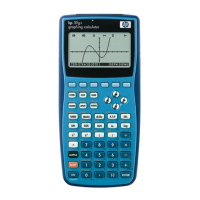Using mathematical functions 10-7
Calculus functions
The symbols for differentiation and integration are available
directly form the keyboard—>GG[@ and )
respectively—as
well as from the MATH menu.
% Differentiates expression with respect to the variable of
differentiation. From the command line, use a formal name
(S1, etc.) for a non-numeric result. See “Finding derivatives”
on page 10-23.
%variable(expression)
Example
%s1(s1
2
+3*s1) returns 2*s1+3
) Integrates expression from lower to upper limits with respect
to the variable of integration. To find the definite integral,
both limits must have numeric values (that is, be numbers or
real variables). To find the indefinite integral, one of the limits
must be a formal variable (s1, etc.).
)(lower,upper,expression,variable)
See “Using formal variables” on page 10-22 for further
details.
Example
)(0,s1,2*X+3,X) >(17(5@*k,
&23<_
>(17(5@ finds the
indefinite result 3*s1+2*(s1^2/2)
See “To find the indefinite integral using formal
variables” on page 10-25 for more information on
finding indefinite integrals.
TAYLOR Calculates the nth order Taylor polynomial of expression at
the point where the given variable = 0.
TAYLOR(expression,variable,n)
Example
TAYLOR(1 + sin(s1)
2
,s1,5)with Radians angle
measure and Fraction number format (set in MODES)
returns 1+s1^2-1/3*s1^4.

